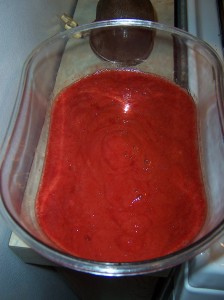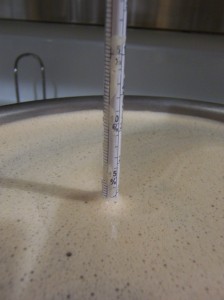This is my basic mead recipe, which is very versatile and can be adapted in as many ways as you can imagine. The recipe comes from my friend and brewing mentor Harper Meader, who developed it over 20 years of trial-and-error experimentation. I have adapted it in several ways, including converting it to 3-gallon batches which I find very convenient to do for mead.
This methodology produces a very sweet mead, which most newbies (and many old-timers) seem to prefer. In reality you can use much less honey if you desire a drier mead. 3/4 of a gallon is still on the sweet side actually. If you prefer to be more precise, then you can use a hydrometer to see where you are. A beginning alcohol potential of 20% will produce an extremely sweet meat. 15% will produce a pretty dry mead. You can start anywhere in between, as you experiment and learn.
The Recipe
Equipment Needed
- 3 gallon carboy
- 3 gallon stockpot
- stopper/airlock
- food-grade plastic tubing (for siphoning)
- large funnel (optional but very helpful)
- strainer (only needed if you brew with herbs or fruits with pits, etc)
Ingredients
- 1 gallon of local, organic (if possible), high quality honey
- 2 gallons of freshly-harvested spring water, preferably that has never touched plastic
- 1 packet of wine yeast
- 6 organic oranges or lemons
- 3 bags of organic black tea
- additional herbs, fruits, or flavorings
In general, use the best quality ingredients you can. The water I use is some of the cleanest water on earth, at 10ppm TDS, that I collect myself from a spring on the top of a mountain. In my opinion, quality water is one of the most important aspects of brewing in general.
For mead, quality honey is important as well. Use honey that has not been heat treated, and has not had toxic chemicals sprayed into the hives for any reason. Your best bet is to find an apiary near you, talk to them, and find out how they produce their honey. I get a gallon of honey from an apiary near me for about $35. The notion of “organic honey” is hazy at best, since bees collect pollen from such a wide geography. The main thing is to make sure the beekeepers aren’t chemically treating or heating their honey. If they aren’t, then it’s likely to be good quality honey.
(addendum, a friend of mine just wrote me with the following: “re organic honey: beehives set into the middle of organic fields will harvest mainly from the closest proximity, so as long as they have enough to collect on the organic farm they will not travel to the non-organic farm a mile down the road. Non-specified commercially available honey, however, is mostly from very heavily pesticide treated crops.”)
I am currently using Red Star Montrachet yeast for my meadmaking, though any sort of wine yeast will do. I haven’t experimented much with using different yeasts, because this yeast works beautifully. I haven’t needed to change, and this yeast is readily available in my area. I do wish to start experimenting with wild yeast.
Wine yeast is expecting grapes, which contain citric acid and tannic acid, 2 things honey does not contain. To compensate for this, we will add oranges or lemons (for the citrus), and black tea (for the tannins).
Additional flavorings can be fruit, herbs, cacao, vanilla, spices, anything your imagination tells you will taste good.
The Process: Brewing night
In a 3 gallon stockpot, add the gallon of honey and about 1.5 gallons of spring water. Stir and mix well. If you need to heat it gently to get the honey to dissolve more completely, then do so but I don’t recommend heating it more than 100 degrees.
Next, add the juice from the oranges/lemons to the pot. Use a small saucepan, and bring a few cups of water to a boil. Put in the 3 bags of black tea, and let steep for 3-4 minutes. Remove the teabags and add the tea to the stockpot.
Then, prepare the yeast. Empty the yeast packet into a small bowl and add some water over the top of it, stir (preferably with wood not metal) and dissolve the yeast. Let it sit for a few minutes until it starts to bubble and smell vaguely of bread.
At this point, you can add any additional flavorings you’d like to use. If you are using fruit, then I like to blend it up (liquify it) in a high-speed blender. Add all the ingredients, and mix well.
Once all the ingredients are in the stockpot, make sure it cools to below 90 degrees (hopefully it never made it above there to begin with). When it’s cool, pour the yeast/water into the bottom of your carboy. Then, pour the must (the liquid in the stockpot) through a funnel into the carboy. It should be less than 3 gallons of liquid, so add additional water to bring it up to 3 gallons. Put a stopper on the carboy, pick it up, and shake it vigorously to dissolve and oxidize the yeast.
Finally, put a stopper on the top of the carboy, and seal it up with an airlock. Within 12-24 hours the mixture will start bubbling vigorously, and the fermentation will have begun!
Note: watch the first day of fermentation very closely. It can get so vigorous that it can literally shoot out the top of the carboy! If this happens, use your siphoning hose in the stopper, and put the other end of the siphoning hose into a bucket filled 1/3 of the way with water. This will allow the fermentation to “blow off” the gases without making a huge mess (this is NO fun to clean up, trust me).
When it stops bubbling: Rack the Mead
3-6 weeks after you put the batch up, the bubbling will slow down and eventually stop, and the mead will begin to clear (all the sediment falls to the bottom). At this stage, I siphon the mead off, leaving the sediment in the bottom, into 1 gallon glass jugs. You should get 2 gallons of clear mead, allow this to continue to ferment and age (seal up the 1 gallon jugs with an airlock). Of the remaining mead in the carboy, get as much clear stuff off the top as possible. Then, you can drink the sediment right away or use it in cooking. It should already be delicious, and will only get better with age!
When it clears: Bottling and Labeling
Once the mead clears even further in the 1 gallon jugs (over the next several weeks/months), it will be ready for bottling. Use your siphon to draw the liquid off the top and fill your bottles. Steam the corks while you are siphoning to both soften and sterilize them. Use a corker to install the corks into the bottles, and put them up! The longer they age the better it will get.
Of course you want to label your meads, if for no other reason that you’ll know what kind it is when you open an aged bottle, long after you forgot about the batches. Get creative! Doing the labels is, in some ways, the most fun part of the process apart from drinking your finished mead.




